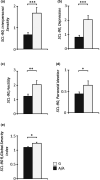The μ-opioid receptor gene A118G polymorphism is associated with insecure attachment in children with disruptive mood regulation disorder and their mothers
- PMID: 32424914
- PMCID: PMC7375094
- DOI: 10.1002/brb3.1659
The μ-opioid receptor gene A118G polymorphism is associated with insecure attachment in children with disruptive mood regulation disorder and their mothers
Abstract
Background: The A118G single nucleotide polymorphism (SNP) of the μ-opioid receptor gene, with high expression of the A allele and low expression of the G allele, has been associated with emotional/behavioral dysregulation and depressive disorders and is recognized as a mediator of affiliative behavior. No study has thus far investigated this SNP in school-age children with disruptive mood regulation disorder (DMDD). This study compared a sample of healthy children and their mothers with a sample of children with DMDD and their mothers, evaluating whether insecure attachment and psychopathological symptoms are associated with A allele- or G allele-carrying mothers and children and whether caregiving capacities are associated with A allele- or G allele-carrying mothers.
Methods: For evaluation of their psychopathological symptoms and attachment styles, mothers filled out the CBCL/6-18, the SCL-90-R, and the ECR. To evaluate the types of relationship children were experiencing with their mothers, children filled out the ECR-revised child version and the PBI. Genotypic analyses were conducted on DNA samples obtained by buccal swabbing from children and mothers.
Results: An insecure attachment style was more frequent in mothers and children carrying the G allele (G/G + A/G genotypes). In the clinical sample, G allele-carrying children scored higher than homozygous A/A ones on the subscales of Withdrawal and Conduct Problems. G-carrying mothers showed higher interpersonal sensitivity, depression, hostility, and paranoid ideation and provided less care than A/A mothers.
Conclusions: This study offers new insights into the associations between the A118G SNP of the μ-opioid receptor gene and emotional/behavioral functioning, attachment style in children, and psychopathology and caregiving ability in mothers.
Keywords: A118G; OPRM1; attachment style; disruptive mood regulation disorder; infant dyad; maternal care; mother; psychopathology.
© 2020 The Authors. Brain and Behavior published by Wiley Periodicals LLC.
Figures






Similar articles
-
Variation in the mu-opioid receptor gene (OPRM1) moderates the influence of maternal sensitivity on child attachment.Transl Psychiatry. 2024 Apr 5;14(1):181. doi: 10.1038/s41398-024-02888-x. Transl Psychiatry. 2024. PMID: 38580654 Free PMC article.
-
Allele frequency and genotype distribution of the opioid receptor μ-1 (OPRM1) A118G polymorphism in the Western Saudi population.J Appl Biomed. 2023 Sep;21(3):160-165. doi: 10.32725/jab.2023.012. Epub 2023 Sep 15. J Appl Biomed. 2023. PMID: 37747315
-
Variation at the mu-opioid receptor gene (OPRM1) influences attachment behavior in infant primates.Proc Natl Acad Sci U S A. 2008 Apr 1;105(13):5277-81. doi: 10.1073/pnas.0710225105. Epub 2008 Mar 31. Proc Natl Acad Sci U S A. 2008. PMID: 18378897 Free PMC article.
-
Effects of OPRM1 A118G polymorphism on epidural analgesia with fentanyl during labor: a meta-analysis.Genet Test Mol Biomarkers. 2013 Oct;17(10):743-9. doi: 10.1089/gtmb.2013.0282. Epub 2013 Aug 2. Genet Test Mol Biomarkers. 2013. PMID: 23909491 Review.
-
Effects of the OPRM1 A118G Polymorphism (rs1799971) on Opioid Analgesia in Cancer Pain: A Systematic Review and Meta-Analysis.Clin J Pain. 2019 Jan;35(1):77-86. doi: 10.1097/AJP.0000000000000636. Clin J Pain. 2019. PMID: 30028366
Cited by
-
Additional Evidence for Neuropsychiatric Manifestations in Mosaic Trisomy 20: A Case Report and Brief Review.Children (Basel). 2021 Nov 10;8(11):1030. doi: 10.3390/children8111030. Children (Basel). 2021. PMID: 34828743 Free PMC article.
-
Factor Structure of the Experiences in Close Relationships-Relationship Structures Scale (ECR-RS) in Siblings of Children with Chronic Disorders.Children (Basel). 2024 May 8;11(5):560. doi: 10.3390/children11050560. Children (Basel). 2024. PMID: 38790555 Free PMC article.
-
Fathers' Cocaine Use and Parent-Child Feeding Interactions.J Clin Med. 2025 Feb 10;14(4):1148. doi: 10.3390/jcm14041148. J Clin Med. 2025. PMID: 40004677 Free PMC article.
-
Utilization of a precision medicine genetic and psychosocial approach in outcome assessment of bariatric weight loss surgery: a narrative review.Front Public Health. 2025 May 1;13:1516122. doi: 10.3389/fpubh.2025.1516122. eCollection 2025. Front Public Health. 2025. PMID: 40376058 Free PMC article. Review.
-
Increased functional coupling of the mu opioid receptor in the anterior insula of depressed individuals.Neuropsychopharmacology. 2021 Apr;46(5):920-927. doi: 10.1038/s41386-021-00974-y. Epub 2021 Feb 2. Neuropsychopharmacology. 2021. PMID: 33531622 Free PMC article.
References
-
- Achenbach, T. M. , & Rescorla, L. A. (2001). Empirically based and DSM‐oriented assessment of preschoolers for pharmacotherapy and other interventions. Child and Adolescent Psychopharmacology News, 6(5), 1–7. 10.1521/capn.6.5.1.22463 - DOI
-
- American Psychiatric Association (2013). Diagnostic and statistical manual of mental disorders, 5th ed Arlington, VA: American Psychiatric Publishing.
-
- Arias, A. , Feinn, R. , & Kranzler, H. R. (2006). Association of an Asn40Asp (A118G) polymorphism in the m‐opioid receptor gene with substance dependence: A meta‐analysis. Drug and Alcohol Dependence, 83, 262–268. - PubMed
-
- Axelson, D. , Findling, R. L. , Fristad, M. A. , Kowatch, R. A. , Youngstrom, E. A. , Horwitz, S. M. , … Birmaher, B. (2012). Examining the proposed disruptive mood dysregulation disorder diagnosis in children in the longitudinal assessment of manic symptoms study. The Journal of Clinical Psychiatry, 73(10), 1342–1350. 10.4088/JCP.12m07674 - DOI - PMC - PubMed
-
- Barr, C. S. , Chen, S. A. , Schwandt, M. L. , Lindell, S. G. , Sun, H. , Suomi, S. J. , & Heilig, M. (2010). Suppression of alcohol preference by naltrexone in the rhesus macaque: A critical role of genetic variation at the m‐opioid receptor gene locus. Biological Psychiatry, 67, 78–80. - PMC - PubMed
Publication types
MeSH terms
Substances
Grants and funding
LinkOut - more resources
Full Text Sources
Research Materials
Miscellaneous

